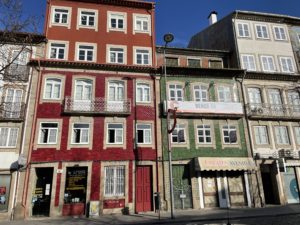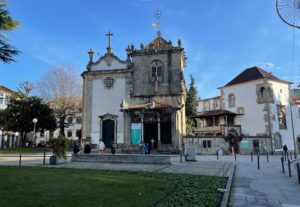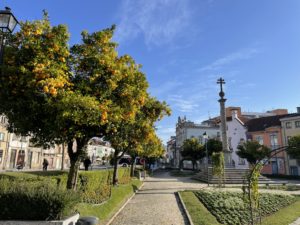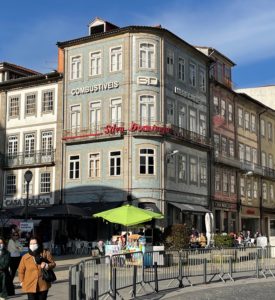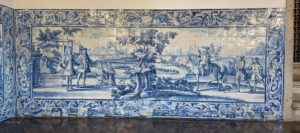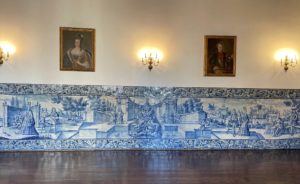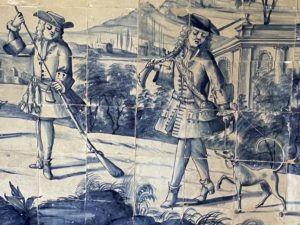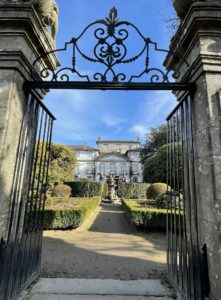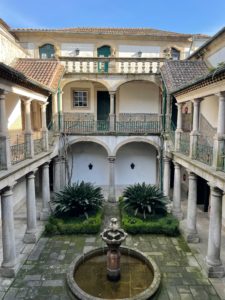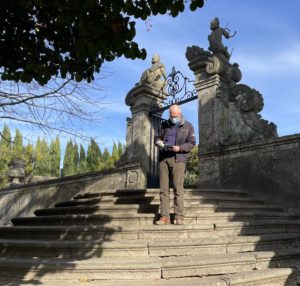In which Sid and Doris see Braga from Roman, through Gothic and Baroque to Modern and hear a Jazz choir sing carols.
Sid spends the night considering what Hermann’s tormenting clicks might mean but as today is Sunday there will be no mechanical help. After the Burgus’ true cyclists’ breakfast (which means it is totally undeserved for non-cyclists) S and D amble off to the Tourist Office which is open. After all, did they not win European Destination of the year for 2021?
Let’s start with some you-are-not-in-the-UK-now pictures. The Portuguese love their tiles, they tile everything and especially the outside of buildings. And oh yes here are some Real Live Open Air Oranges (don’t eat them) (don’t ask how Sid knows that).
There are still plenty of towers from the walls which now dot the old town. Braga stands to Portugal as Canterbury does to England. There are many churches, some with a few bits of Romanesque about them, the prime building style being Gothic. Inside there has been much Rococo blinging up with gold-leaf-wrapped cherubs zooming about like Fotherington Thomas pretending to be a Spitfire.
As ever a merchant’s house visit is a great draw for S and D. The local version is the Biscainhos Museum. The reference to Biscay is because when Constantino Ribeiro do Lago, one of the great and good of the town, built the palace in the late 17th century the craftsmen here working on the churches were from the Basque country on Biscay. The house was extended many times until the early 19th century. The pattern of wings and courtyards does not seem so different from a Roman villa or a Moorish palace. It does have the full gamut of local ceramic tiling, painted chestnut ceilings and stucco mouldings. In the 1960s it was taken over by the town for a museum but it was too much for them and it is now run by the state.
Just now there are no guided tours and we were chaperoned from room to room with half a dozen others.
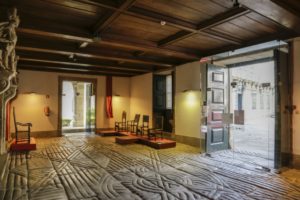 On the ground floor the floors are ridged to give a grip for the horses’ hooves. Because this house has an amazing drive-through feature, the entire carriage would be driven into this front room. And the ridges continue down a corridor to the stables which are simply one room at the back of the house. We then spent a few moments agreeing with our guide that the carriage currently on display in the stables couldn’t have managed the narrow turn from the corridor into the stables. Detective mode switched on, and Sid spotted a wider door to the garden and yard, and at the far end a gate directly to the street so supplies can come into the kitchens and stables without coming through the house. Of course.
On the ground floor the floors are ridged to give a grip for the horses’ hooves. Because this house has an amazing drive-through feature, the entire carriage would be driven into this front room. And the ridges continue down a corridor to the stables which are simply one room at the back of the house. We then spent a few moments agreeing with our guide that the carriage currently on display in the stables couldn’t have managed the narrow turn from the corridor into the stables. Detective mode switched on, and Sid spotted a wider door to the garden and yard, and at the far end a gate directly to the street so supplies can come into the kitchens and stables without coming through the house. Of course.
Some more photos of the outside of the house just because it was all very pretty:
Next stop is the promise of a first century mosaic. Doris dearly loves a mosaic. The Dom Diogo de Sousa museum is built over a Roman villa close by the Bracara Augusta town baths. This was the capital of Galicia until the Swabians came in 410. 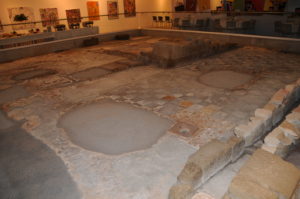 The villa dates from the first century. It was a bit tricky to find the mosaic, which was accessed via two closed doors and an unlabelled staircase, and when we finally got there we realised why. Sometime in the past people took away the pretty pictures, so there are lots of borders and then some big holes in the middle where the interesting bits were. Perhaps we should have worked this out from the absence of museum signage or enticing photos in the town guide. Even Doris didn’t take a picture although thanks to the miracle of the Internet, we can show you one that someone else took. Still, the models of the baths at about one thirty second scale were very satisfying. And a German couple now living locally, Buhler-Bockhaus from Stuttgart, have added their excellent collection of Roman pottery and such to the museum. One of the better Swabian invasions. Interestingly, the BB’s also donated a couple of very nice little mosaic panels with some animals and people on them in excellent detail. We wondered where they were originally from…
The villa dates from the first century. It was a bit tricky to find the mosaic, which was accessed via two closed doors and an unlabelled staircase, and when we finally got there we realised why. Sometime in the past people took away the pretty pictures, so there are lots of borders and then some big holes in the middle where the interesting bits were. Perhaps we should have worked this out from the absence of museum signage or enticing photos in the town guide. Even Doris didn’t take a picture although thanks to the miracle of the Internet, we can show you one that someone else took. Still, the models of the baths at about one thirty second scale were very satisfying. And a German couple now living locally, Buhler-Bockhaus from Stuttgart, have added their excellent collection of Roman pottery and such to the museum. One of the better Swabian invasions. Interestingly, the BB’s also donated a couple of very nice little mosaic panels with some animals and people on them in excellent detail. We wondered where they were originally from…
For the rest of the tour Sid and Doris were happy to gorm from a distance, such as the Tower of the Virgin. There are also Art Nouveau and 1930s modern buildings, such as the tourist office. Though the town now has about 130,000 people the old town is splendidly intact, perhaps because Portugal under the various repressive regimes from 1910 to 1974 had made for a rather unproductive economy. Even now the GDP per head is about the same as Slovakia or Poland, now also though more recently part of political Europe but equally with a history of politics unconducive to productivity.
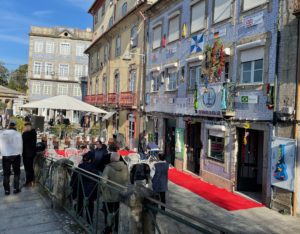 We also came across a quite unexplained scene between a woman leaning out of a window shouting at a group of men across the road who appeared to be preparing to play ukuleles and castanets. She retired defeated, probably to put in her much-used earplugs.
We also came across a quite unexplained scene between a woman leaning out of a window shouting at a group of men across the road who appeared to be preparing to play ukuleles and castanets. She retired defeated, probably to put in her much-used earplugs.
On returning to the Burgus hotel Sid went to dip Hermann’s oil after his heroic 380 mile run. Either little has been burned or he was over-filled. A look for the starter motor and solenoid is not encouraging. They are under the exhaust manifold and will only be reached from below, but he starts first turn of the key.
On the tour of the town S and D have spotted a concert by a jazz choir. Last night, due to the fog and late arrival, we missed a major town fete, although fortunately due to our poor advance research we didn’t realise that until this morning. Tonight Sid has decided against getting a late entry for the ten kilometre run. In the UK or France Sid might have had a go yet speaking no Portuguese there would be no connection. But a chorus, we know about them. And of course we’ll be sitting down. We have ordered another cyclists’ breakfast for the morning. Busy, busy.
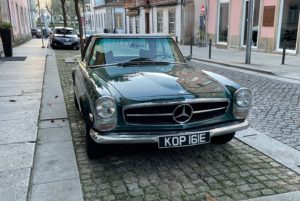 We sit writing this, admiring people admiring Hermann who is parked immediately outside the hotel. And who wouldn’t, he is very pretty.
We sit writing this, admiring people admiring Hermann who is parked immediately outside the hotel. And who wouldn’t, he is very pretty.
 As darkness fell the choir concert was held in a marquee in the grounds of the Capella e Casa dos Coimbras, with a bar and a goodish audience muffled up in coats and scarves. The four men and dozen women were conducted from an electric piano. They sang well and entirely in English which seemed odd. Some straight carols and a few jazzed-up ones. You could imagine a jazzed-up In the Bleak Mid-Winter, and maybe you wouldn’t want to.
As darkness fell the choir concert was held in a marquee in the grounds of the Capella e Casa dos Coimbras, with a bar and a goodish audience muffled up in coats and scarves. The four men and dozen women were conducted from an electric piano. They sang well and entirely in English which seemed odd. Some straight carols and a few jazzed-up ones. You could imagine a jazzed-up In the Bleak Mid-Winter, and maybe you wouldn’t want to.
Dinner on the main square in an Italian cafe. And so to bed.
